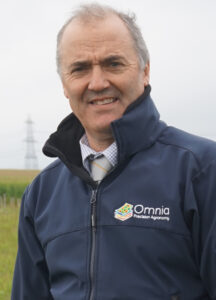As growers come under increased pressure to look at their carbon footprint, Hutchinsons has launched TerraMap Carbon – a combination of hardware and software designed to help farmers measure their organic and active carbon baselines and make management decisions in the drive to meet net zero.
It’s a development of the company’s TerraMap system, which has been measuring soil nutrients since 2018. It uses gamma-ray detection to measure naturally emitted isotopes like caesium and potassium. The infield process is done in two steps; firstly by driving a lightweight vehicle, equipped with the sensor, across the field, and then taking soil samples to allow for each to be used to create individual map laters.
“The consistency and reliability of the results from TerraMap are proven, reflected in its uptake on over 35,000ha’s on UK farms since its launch in 2018,” Matt Ward, Hutchinsons services manager.

TerraMap Carbon is available as a standard or premium package. The standard service maps a total of 17 micronutrients, soil types and pH layers that now also includes total organic carbon as a percentage and in tonnes per hectare. The premium service maps 27 layers, including a wider range of micronutrients, cation exchange and both organic and active carbon percentages and tonnes per hectare.
Why we should measure carbon
Mr Ward explained why UK farmers should be measuring their carbon levels: “The pressure to manage carbon is only going to become greater as other industries are already showing positive change. As an industry UK farming plc is in a unique and enviable position as farming activities can make positive changes to carbon, which most other industries are not able to do.
“This challenge comes at a time when the arable industry is facing great change in the light of the loss of basic farm payment, and many growers may well be questioning the importance or relevance of carbon management as potential profit margins are threatened.
“We need to move away from seeing carbon footprinting as a burden or simply a tick-box exercise and see that this is beneficial, as a proxy measurement for efficiency and profitability of a farm as well as simply a measure of waste.
“So it’s clear that there are benefits such as lower input costs to having a negative carbon balance before even getting to the Carbon bit. A reduced carbon footprint can only be achieved through more efficient fertilisers, different technologies, better soil carbon management or considering the energy used in storage, so it’s a win-win on all levels.”

Omnia Carbon Management
According to Mr Ward, one of the most common questions is how the carbon information gathered can then be used to make positive changes on the farm. Results from the TerraMap Carbon can be used to create carbon maps with the Omnia Carbon management system, which aligns the measurements against the carbon costs of different operations, incorporating detailed calculations for power, width, work rate and fuel – using data from the Farm Carbon Toolkit.
Within the software, it’s possible to create different rotation scenarios from cropping varieties to stewardship and management practices, and see first-hand the project CO2 impact and financial performance.
“We wanted to move away from just presenting carbon figures on a spreadsheet into a visible and useable format- that can be used for forward planning much as we have done with the Cost of Production tool in Omnia,” added Mr Ward.
“It’s not always the grand gestures that make the difference, and this is where the ability to look at different scenarios is invaluable. For example, it might be more beneficial to put more land into ELMs and sequester more carbon this way than to replace or change machinery.”
TerraMap Carbon in practice
Yorkshire farmer Nick Wilson is part of the Hutchinsons Helix Farms network where TerraMap Carbon has been trialled. The farm consists of 260 hectares of mainly arable cropping, with land let out for potatoes and winter sheep grazing on stubble turnips. Additionally, there is also bed & breakfast cattle to utilise farm buildings and some of the permanent grassland.
For Mr Wilson and his agronomist Sam Hugill, carbon is a part of the whole farm system but both believe it is useful to obtain a baseline measurement now.
“The results of the TerraMap Carbon scanning showed up large differences in the carbon balance between the arable fields and permanent pasture, as you would expect. The average across the arable fields was about 30t/ha of organic carbon and it was almost double that for the permanent pasture,” Mr Wilson explained.

“Now that we have a baseline measurement, we can look not just how we can manage our processes to build carbon on the arable fields up to the levels of that of the pasture, but also to prevent any unnecessary losses of carbon. For example, we would be interested to look at the impact of root crops on carbon. We will also use cover cropping to prevent having any bare land over winter and reducing loss this way,” said Mr Hugill.
“The carbon management tool allows us to look at these scenario’s using real and accurate measurements and then quantify the impact on our carbon.”
For Mr Wilson, the bottom line is that he is a food producer, and managing carbon has to fit into that.
”We always look at what we do and how we can do better and carbon is a part of that – how much we do about it will ultimately be driven by policy – but whatever decisions we make on-farm have to be good for us agronomically and economically in the first instance.
“It’s all about adapting what we do rather than radical change- and being able to measure what we have is the first step.”
For more information go to www.hlhltd.co.uk


